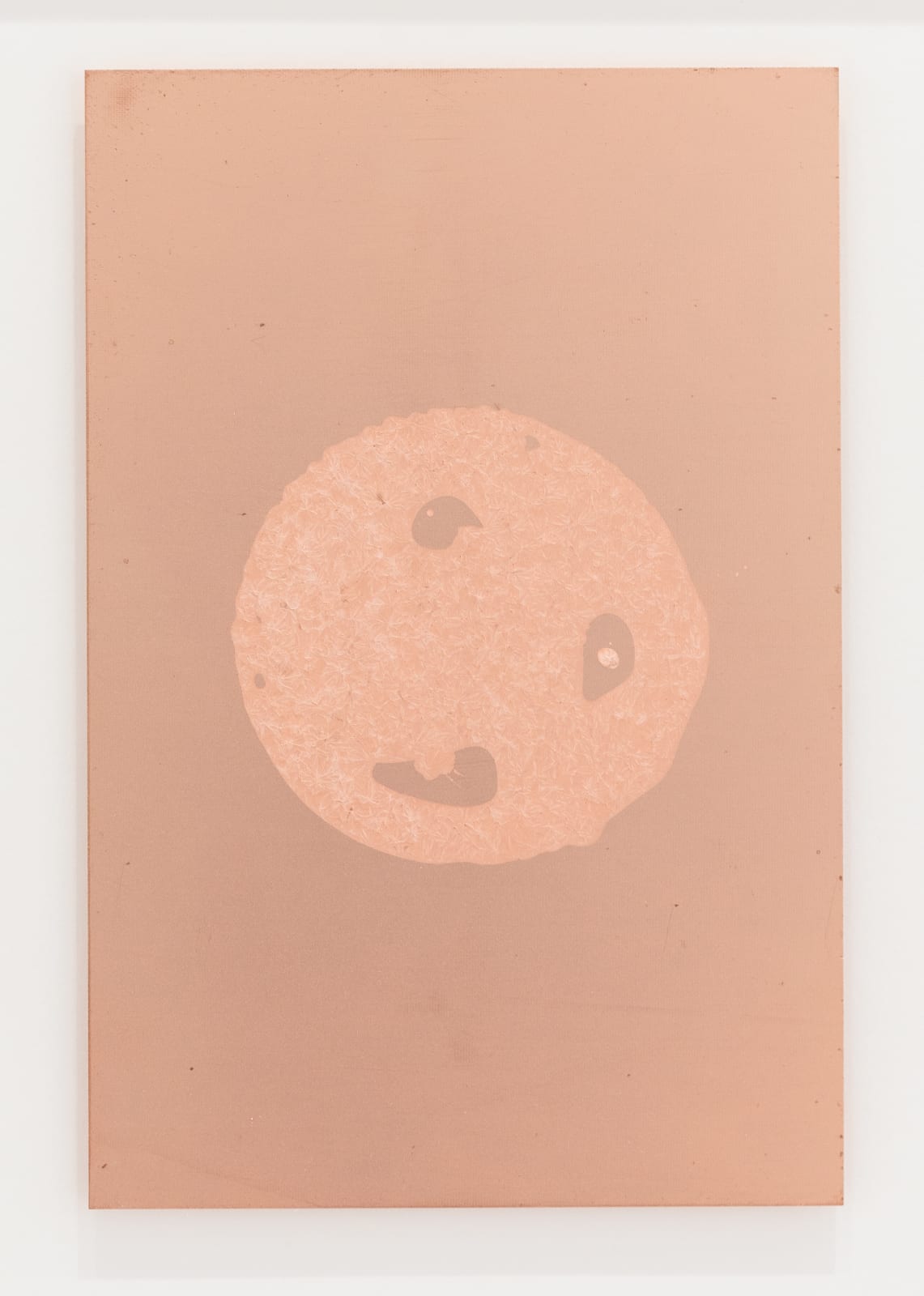Haroon Mirza
Sugar Face, 2017
Refined sugar electroetching on copper PCB blank
Frame:
51 x 40.5 x 4cm
201/8 x 16 x 15/8 inches
Copper PCB:
30 x 20 cm
11 3/4 x 7 7/8 inches
51 x 40.5 x 4cm
201/8 x 16 x 15/8 inches
Copper PCB:
30 x 20 cm
11 3/4 x 7 7/8 inches
Copyright The Artist
Photo: Dirk Tacke
Further images
"Sugar Face" (2017) ist Teil der Serie Electro Etchings, in der Haroon Mirza organische Elemente, wie psychoaktive Pflanzen und Pilze, oder wie hier, raffinierten Zucker auf kupfernen Leiterplatten positioniert und diese unter Strom setzt. Bei diesem Prozess verbinden sich der Zucker und das Metall sodass sich die kristallinen Umrisse in das Material einschreiben. Der Konsum von Zucker aktiviert das Belohnungszentrum im Gehirn wodurch Dopamin freigesetzt wird. Damit teilt Zucker einige Eigenschaften mit klassischen Drogen und hat Auswirkungen auf das Empfinden von Menschen, mit dem sich der Künstler auseinandersetzt. Elektrizität ist ein immer wiederkehrendes Medium in Mirzas künstlerischer Praxis und Ausdruck seiner langjährigen Auseinandersetzung mit Energie(wellen), in physikalischen und spirituellen Kontexten: „Waves have been a preoccupation of mine since the beginning of my practice. There’s a thread that’s very clear, though I didn’t realise it at the time. From ocean waves to soundwaves, from electromagnetic waves to brain waves, I’m very attracted to chaotic systems—waves, electricity, energy—that are present in nature, and how our perceptual apparatus engages with them.”
"Sugar Face" (2017) is part of the "Electro Etchings" series, in which Haroon Mirza places organic elements such as psychoactive plants and mushrooms, or in this case, refined sugar, on copper circuit boards and conducts electrical currents through them. In this process, sugar and metal combine, allowing the crystalline outlines to inscribe themselves into the material. The consumption of sugar activates the reward center in the brain, leading to the release of dopamine. In this way, sugar shares some characteristics with classical drugs and has an impact on human perception, which the artist engages with. Electricity is a recurring medium in Mirza's artistic practice, expressing his longstanding exploration of energy (waves) in both physical and spiritual contexts: “Waves have been a preoccupation of mine since the beginning of my practice. There’s a thread that’s very clear, though I didn’t realize it at the time. From ocean waves to soundwaves, from electromagnetic waves to brain waves, I’m very attracted to chaotic systems – waves, electricity, energy – that are present in nature, and how our perceptual apparatus engages with them.”
Created by placing organic material on copper boards and passing a current through them, Haroon Mirza’s electro-etchings fuse together the technoid-digital world and the natural, shamanistic-magical world by using organic material. "I've always been interested in organic matter, material, and organisms because of their chaotic, unpredictable and autonomous nature, and also as a metaphor for other things", the artist stated in an interview. The usage of PCB copper plates (which are normally used in computers) and drugs in shamanistic rituals is also found in other works of his internationally recognized installations, sculptures and video pieces.
The work OxyContin is related to the dramatic increase in Oxycodone abuse in the USA and refers to the prescription drug OxyContin, which contains the substance Oxycodone, an opioid which is largely credited to be the source of the opioid crises in the USA. While a sliced ginger root is placed on a electrified PCB copper plate for 6 minutes, the ginger root reacts with the plate and leaves permanent marks. Other works of the series also show a chemical reaction of the San Pedro cactus on the copper surface or other traces of organic material like garlic flowers or are connected to other drugs. For instance, Mirza made copper plates with Liberty Caps, which is the most common psychoactive mushroom.
The work OxyContin is related to the dramatic increase in Oxycodone abuse in the USA and refers to the prescription drug OxyContin, which contains the substance Oxycodone, an opioid which is largely credited to be the source of the opioid crises in the USA. While a sliced ginger root is placed on a electrified PCB copper plate for 6 minutes, the ginger root reacts with the plate and leaves permanent marks. Other works of the series also show a chemical reaction of the San Pedro cactus on the copper surface or other traces of organic material like garlic flowers or are connected to other drugs. For instance, Mirza made copper plates with Liberty Caps, which is the most common psychoactive mushroom.











